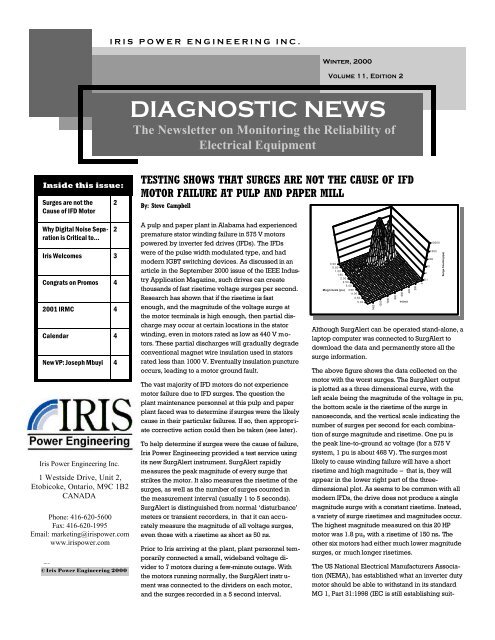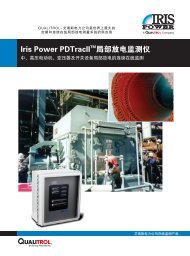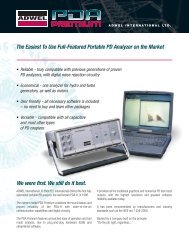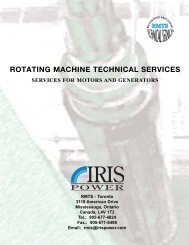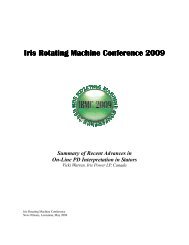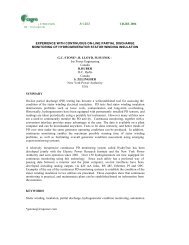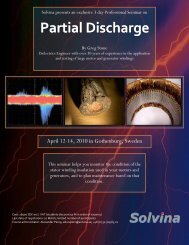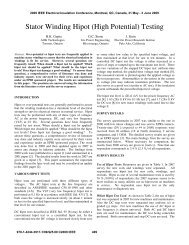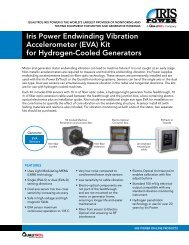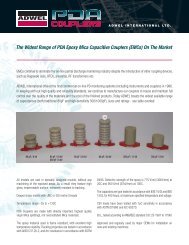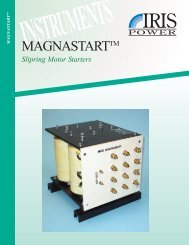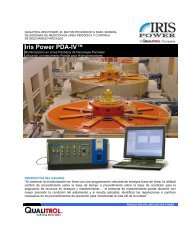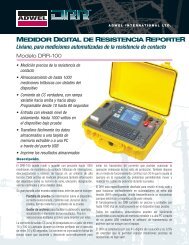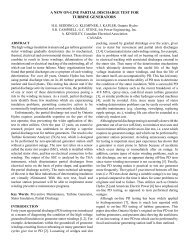to download PDF - Iris Power Engineering
to download PDF - Iris Power Engineering
to download PDF - Iris Power Engineering
Create successful ePaper yourself
Turn your PDF publications into a flip-book with our unique Google optimized e-Paper software.
0<br />
IRIS POWER ENGINEERING INC.<br />
Winter, 2000<br />
Volume 11, Edition 2<br />
DIAGNOSTIC NEWS<br />
The Newsletter on Moni<strong>to</strong>ring the Reliability of<br />
Electrical Equipment<br />
Inside this issue:<br />
Surges are not the<br />
Cause of IFD Mo<strong>to</strong>r<br />
2<br />
TESTING SHOWS THAT SURGES ARE NOT THE CAUSE OF IFD<br />
MOTOR FAILURE AT PULP AND PAPER MILL<br />
By: Steve Campbell<br />
Why Digital Noise Separation<br />
is Critical <strong>to</strong>...<br />
<strong>Iris</strong> Welcomes 3<br />
Congrats on Promos 4<br />
2001 IRMC 4<br />
Calendar 4<br />
New VP: Joseph Mbuyi 4<br />
<strong>Iris</strong> <strong>Power</strong> <strong>Engineering</strong> Inc.<br />
1 Westside Drive, Unit 2,<br />
E<strong>to</strong>bicoke, Ontario, M9C 1B2<br />
CANADA<br />
Phone: 416-620-5600<br />
Fax: 416-620-1995<br />
Email: marketing@irispower.com<br />
www.irispower.com<br />
©<strong>Iris</strong> <strong>Power</strong> <strong>Engineering</strong> 2000<br />
2<br />
A pulp and paper plant in Alabama had experienced<br />
premature sta<strong>to</strong>r winding failure in 575 V mo<strong>to</strong>rs<br />
powered by inverter fed drives (IFDs). The IFDs<br />
were of the pulse width modulated type, and had<br />
modern IGBT switching devices. As discussed in an<br />
article in the September 2000 issue of the IEEE Industry<br />
Application Magazine, such drives can create<br />
thousands of fast risetime voltage surges per second.<br />
Research has shown that if the risetime is fast<br />
enough, and the magnitude of the voltage surge at<br />
the mo<strong>to</strong>r terminals is high enough, then partial discharge<br />
may occur at certain locations in the sta<strong>to</strong>r<br />
winding, even in mo<strong>to</strong>rs rated as low as 440 V mo<strong>to</strong>rs.<br />
These partial discharges will gradually degrade<br />
conventional magnet wire insulation used in sta<strong>to</strong>rs<br />
rated less than 1000 V. Eventually insulation puncture<br />
occurs, leading <strong>to</strong> a mo<strong>to</strong>r ground fault.<br />
The vast majority of IFD mo<strong>to</strong>rs do not experience<br />
mo<strong>to</strong>r failure due <strong>to</strong> IFD surges. The question the<br />
plant maintenance personnel at this pulp and paper<br />
plant faced was <strong>to</strong> determine if surges were the likely<br />
cause in their particular failures. If so, then appropriate<br />
corrective action could then be taken (see later).<br />
To help determine if surges were the cause of failure,<br />
<strong>Iris</strong> <strong>Power</strong> <strong>Engineering</strong> provided a test service using<br />
its new SurgAlert instrument. SurgAlert rapidly<br />
measures the peak magnitude of every surge that<br />
strikes the mo<strong>to</strong>r. It also measures the risetime of the<br />
surges, as well as the number of surges counted in<br />
the measurement interval (usually 1 <strong>to</strong> 5 seconds).<br />
SurgAlert is distinguished from normal ‘disturbance’<br />
meters or transient recorders, in that it can accurately<br />
measure the magnitude of all voltage surges,<br />
even those with a risetime as short as 50 ns.<br />
Prior <strong>to</strong> <strong>Iris</strong> arriving at the plant, plant personnel temporarily<br />
connected a small, wideband voltage divider<br />
<strong>to</strong> 7 mo<strong>to</strong>rs during a few-minute outage. With<br />
the mo<strong>to</strong>rs running normally, the SurgAlert instr u-<br />
ment was connected <strong>to</strong> the dividers on each mo<strong>to</strong>r,<br />
and the surges recorded in a 5 second interval.<br />
0.00<br />
0.50<br />
1.00<br />
1.50<br />
2.00<br />
Magnitude (pu)<br />
2.50<br />
3.00<br />
3.50<br />
4.00<br />
4.50<br />
5.00<br />
1400<br />
1200<br />
1000<br />
Although SurgAlert can be operated stand-alone, a<br />
lap<strong>to</strong>p computer was connected <strong>to</strong> SurgAlert <strong>to</strong><br />
<strong>download</strong> the data and permanently s<strong>to</strong>re all the<br />
surge information.<br />
The above figure shows the data collected on the<br />
mo<strong>to</strong>r with the worst surges. The SurgAlert output<br />
is plotted as a three dimensional curve, with the<br />
left scale being the magnitude of the voltage in pu,<br />
the bot<strong>to</strong>m scale is the risetime of the surge in<br />
nanoseconds, and the vertical scale indicating the<br />
number of surges per second for each combination<br />
of surge magnitude and risetime. One pu is<br />
the peak line-<strong>to</strong>-ground ac voltage (for a 575 V<br />
system, 1 pu is about 468 V). The surges most<br />
likely <strong>to</strong> cause winding failure will have a short<br />
risetime and high magnitude – that is, they will<br />
appear in the lower right part of the threedimensional<br />
plot. As seems <strong>to</strong> be common with all<br />
modern IFDs, the drive does not produce a single<br />
magnitude surge with a constant risetime. Instead,<br />
a variety of surge risetimes and magnitudes occur.<br />
The highest magnitude measured on this 20 HP<br />
mo<strong>to</strong>r was 1.8 pu, with a risetime of 150 ns. The<br />
other six mo<strong>to</strong>rs had either much lower magnitude<br />
surges, or much longer risetimes.<br />
The US National Electrical Manufacturers Association<br />
(NEMA), has established what an inverter duty<br />
mo<strong>to</strong>r should be able <strong>to</strong> withstand in its standard<br />
MG 1, Part 31:1998 (IEC is still establishing suit-<br />
800<br />
600<br />
tr (ns)<br />
400<br />
200<br />
1<br />
0.1<br />
10<br />
1000<br />
100<br />
10000<br />
Surge Counts (pps)
Page 2<br />
“put good quote here”<br />
DIAGNOSTIC NEWS<br />
WHY DIGITAL NOISE SEPARATION IS CRITICAL<br />
TO PARTIAL DISCHARGE TEST CREDIBILITY<br />
By Greg S<strong>to</strong>ne<br />
The key characteristic of the <strong>Iris</strong> on-line<br />
PD technology, originally developed by<br />
Ontario Hydro in research funded by the<br />
Canadian Electrical Association, is that<br />
electrical noise is separated from sta<strong>to</strong>r<br />
winding partial discharge (PD) using digital<br />
pulse-by-pulse technology. Although<br />
many other technologies are on the market,<br />
and all can detect PD, these other<br />
systems use analog noise separation<br />
methods (filters, differential amplifiers,<br />
etc.) or employ ‘gating’ systems where<br />
experienced test personnel are needed <strong>to</strong><br />
find noise sources and/or set noise thresholds.<br />
Electrical noise is caused by many<br />
sources in operating plants: corona from<br />
overhead power lines, brushgear sparking,<br />
electrostatic precipita<strong>to</strong>rs, power <strong>to</strong>ol<br />
operation, inverter drives, etc. All of these<br />
noise sources create electrical pulses that<br />
have many of the same characteristics as<br />
pulses caused by sta<strong>to</strong>r winding PD. Yet,<br />
for the most part, these noise sources are<br />
relatively harmless or even normal. If the<br />
noise environment is severe, the noise<br />
will give rise <strong>to</strong> higher pulses than the PD,<br />
and thus the PD signals may be obscured. If<br />
the noise is mistaken for PD, then the unwary<br />
user may assume that the winding is deteriorated,<br />
when it is not. This is called a false<br />
positive test result. The consequence of the<br />
false positive is that the machine must usually<br />
be shut down for either off-line tests, or<br />
a visual inspection. If nothing is found, the<br />
shutdown, with an associated loss of production<br />
and maintenance costs, was unnecessary.<br />
Since in fact only a small percentage of<br />
sta<strong>to</strong>rs are actually significantly deteriorated<br />
at any one time, even a low percentage of<br />
false positives can result in more machines<br />
being identified as bad, than the number of<br />
machines correctly being identified as bad.<br />
In addition <strong>to</strong> preventing false indications,<br />
digitally separating PD from noise has other<br />
benefits, including:<br />
• if desired, plant staff can perform all<br />
testing and most interpretations. This<br />
lowers overall test cost<br />
• once noise is separated, the PD magnitudes<br />
can be compared against the <strong>Iris</strong><br />
database, so that users can objectively<br />
“In addition <strong>to</strong> preventing<br />
false indications, digitally<br />
separating PD from noise<br />
has other benefits…”<br />
determine the relative winding condition<br />
with only one test. Since the definitions<br />
of ‘good’ and ‘bad’ windings are<br />
published in the public domain, they<br />
are not subject <strong>to</strong> redefinition, depending<br />
on vested interests<br />
• if the noise environment changes over<br />
time, no further visits <strong>to</strong> the plant by an<br />
expert are needed <strong>to</strong> readjust the filtering<br />
or the noise gating systems. The<br />
pulse-by-pulse noise separation system<br />
– CONTINUED FROM PAGE 1 –<br />
TESTING SHOWS THAT SURGES ARE NOT THE CAUSE OF IFD MOTOR FAILURE AT PULP AND PAPER MILL<br />
By: Steve Campbell<br />
The standard says the sta<strong>to</strong>r should be capable<br />
of withstanding surges less than 3.7 pu,<br />
and a risetime longer than 100 ns. Since the<br />
surges on this mo<strong>to</strong>r are much less than the<br />
3.7 pu allowed, the conclusion is that the<br />
mo<strong>to</strong>r should be capable of withstanding the<br />
surge environment. The other 6 mo<strong>to</strong>rs have<br />
an even lower risk of failure due <strong>to</strong> surges.<br />
Since mo<strong>to</strong>rs may sometimes not meet<br />
specifications, the capability of several mo<strong>to</strong>rs<br />
(regrettably not the mo<strong>to</strong>rs that already<br />
failed) was directly measured. A Baker<br />
Model D12000 surge tester, capable of outputting<br />
100 ns risetime surges <strong>to</strong> the mo<strong>to</strong>r,<br />
was used <strong>to</strong> apply surges <strong>to</strong> mo<strong>to</strong>rs disconnected<br />
from the power system.<br />
All mo<strong>to</strong>rs tested withs<strong>to</strong>od the NEMA<br />
surges of 3.7 pu (1740 V). One mo<strong>to</strong>r, with<br />
the same rating as the mo<strong>to</strong>r experiencing<br />
the worst surges, was energized <strong>to</strong> 2600 V,<br />
and did not fail. In addition, the partial discharge<br />
activity on these mo<strong>to</strong>rs was measured<br />
with <strong>Iris</strong>’s XTrac PD detec<strong>to</strong>r, while the<br />
surges were being applied. No PD was detected<br />
below 3.7 pu, and, in fact, the 20 HP<br />
mo<strong>to</strong>r only experienced PD above about<br />
2600 V. Clearly, the mo<strong>to</strong>rs tested should not<br />
suffer from PD induced by IFD switching<br />
surges at this plant.<br />
This testing regime was able <strong>to</strong> conclude<br />
objectively that surges are unlikely <strong>to</strong> cause<br />
failure in the specific plant environment in<br />
date seems <strong>to</strong> indicate that most mo<strong>to</strong>rs<br />
have a significantly less severe surge environment<br />
than would be expected from<br />
simple analytical techniques that can be<br />
used <strong>to</strong> estimate the surge environment.<br />
If SurgAlert does find a mo<strong>to</strong>r with a severe<br />
surge environment which exceeds<br />
NEMA ratings, then plant owners can consider<br />
a variety of methods <strong>to</strong> reduce surge<br />
severity, including adding filters, altering<br />
cable length and/or grounding, and upgrading<br />
the sta<strong>to</strong>r winding insulation system.<br />
Since all of these measures can be<br />
expensive, it is best <strong>to</strong> determine first if<br />
they are necessary using SurgAlert.
Page 3<br />
INCREASING LOCAL PRESENCE<br />
Marta Blocki joins <strong>Iris</strong> as<br />
their new Communications<br />
Coordina<strong>to</strong>r. Her main duties<br />
involve coordinating<br />
tradeshows, courses and<br />
conferences, while attending<br />
<strong>to</strong> advertising and other media/communications<br />
related<br />
responsibilities. A recent<br />
Mass Communications and<br />
English graduate from<br />
Carle<strong>to</strong>n University in Ottawa,<br />
Marta enjoys writing,<br />
and drawing in her spare<br />
time, that is, when she can<br />
find it.<br />
Khanano has come aboard the<br />
sensor and kits department just<br />
two short weeks ago. As a<br />
member of manufacturing and<br />
support staff, Khanano will be<br />
primarily involved in building<br />
up manufacturing. Apart from<br />
his avid interest in music, playing<br />
guitar and sports, Khanano<br />
boasts of a three-year electronics<br />
degree which he attained in<br />
Iraq.<br />
————————————<br />
A graduate from Leeds Metropolitan<br />
University in England,<br />
Mark’s academic background<br />
mainly involves electronic engineering.<br />
As our Junior Software<br />
Engineer, Mark is expecting<br />
some intensive training<br />
ahead. Some temporary cutbacks<br />
in football (or soccer, as<br />
we understand it) may very<br />
Marta Blocki<br />
Communications<br />
Coordina<strong>to</strong>r<br />
mblocki@irispower.com<br />
(416) 620-5600 X 241<br />
Khanano Khanano<br />
General Support Worker<br />
(416) 620-5600 X 239<br />
Mark Credland<br />
Junior Software Engineer<br />
mcredland@irispower.com<br />
(416) 620-5600 X 274<br />
Eugene joins us with a long his<strong>to</strong>ry<br />
of experience in the industry<br />
under his belt. Before his arrival<br />
<strong>to</strong> Canada, Eugene worked in the<br />
circuit board industry, plant<br />
management and business. After<br />
his departure from Belarus he<br />
has dabbled in technical support,<br />
field service and applications.<br />
Currently Eugene is <strong>Iris</strong>’s<br />
new International Projects Manager<br />
– who knows what the future<br />
will hold for him!<br />
———————————————<br />
Rajiv is the latest addition <strong>to</strong> <strong>Iris</strong>’s<br />
marketing department under the<br />
title of Applications Specialist.<br />
He joins the <strong>Iris</strong> marketing team<br />
with a combination of qualifications<br />
in engineering and information<br />
technology, not <strong>to</strong> mention<br />
a broad-based learning aptitude.<br />
Over the years, Rajiv has<br />
gained knowledge and expertise<br />
in numerous fields, namely sales,<br />
designing, system analysis, installation<br />
and maintenance of<br />
engineering products.<br />
IRIS ALSO WELCOMES...<br />
<strong>Iris</strong>’ new technical direc<strong>to</strong>r,<br />
Andy Brown, has assumed his<br />
position at our new UK office in<br />
Nantwich near Manchester.<br />
Andy’s responsibilities include<br />
expanding <strong>Iris</strong>’s test service<br />
and rotating/electrical plant<br />
condition assessment. With<br />
prior experience in working<br />
for large engineering companies<br />
like Nuclear Electric and<br />
Mott MacDonald, we have complete<br />
faith in his elaborate reper<strong>to</strong>ire<br />
of expertise.<br />
Eugene Kazlou<br />
International Projects Manager<br />
ekazlou@irispower.com<br />
(416) 620-5600 X 244<br />
Rajiv Sharma<br />
Applications Specialist<br />
rsharma@irispower.com<br />
Andy Brown<br />
Technical Direc<strong>to</strong>r<br />
abrown@irispower.com<br />
(0) 1270-615020<br />
(0) 1477-549073<br />
INDUSTRY NOTES<br />
Don Speer has become a consultant<br />
specializing in insulation materials<br />
development and evaluation. Most of his<br />
recent work has been on subjects related <strong>to</strong> magnet<br />
wire insulation and processing of sta<strong>to</strong>r windings.<br />
Don can be reached at 636-949-3149, or by<br />
e-mail: donaldspeer@netscape.net<br />
Dr. George Gao has joined the corporate R&D<br />
center of General Electric. Dr. Gao has been an<br />
active developer of rotating machine insulation<br />
systems, most recently at TECO<br />
Westinghouse. He can be contacted at<br />
(518) 387-6219, or by e-mail:gaoge@crd.<br />
ge.com<br />
Dr. Bal Gupta of Hydro Ontario has retired.<br />
He is a well-known researcher of<br />
rotating machine failure mechanisms and<br />
test procedures. Dr. Gupta is now a consultant<br />
specializing in these areas. He can<br />
be reached at (416) 621-6035, or by e-mail<br />
at: b.gupta@ieee.org<br />
IEEE 1434-2000 has finally been published.<br />
This guide discusses the benefits of<br />
partial discharge testing of rotating machines,<br />
and outlines all the various off-line<br />
and on-line methods. The guide was produced<br />
under the chairmanship of Bill<br />
McDermid of Mani<strong>to</strong>ba Hydro. To order<br />
IEEE Std 1434-2000, call (800) 678-4333 in<br />
the U.S.A. and Canada, or from other countries<br />
call (732) 981-0600. Orders by fax<br />
may be sent <strong>to</strong> (732) 981-9667. For Web<br />
access <strong>to</strong> IEEE standards information visit
<strong>Iris</strong> <strong>Power</strong> <strong>Engineering</strong> Inc.<br />
Calendar 2000/2001<br />
1 Westside Drive, Unit 2,<br />
E<strong>to</strong>bicoke, Ontario, M9C 1B2<br />
CANADA<br />
Phone: 416-620-5600<br />
Fax: 416-620-1995<br />
Email: marketing@irispower.com<br />
www.irispower.com<br />
December 31<br />
Jan 15-18<br />
Jan 23-25<br />
www.irispower.com<br />
Paper abstracts due for IRMC<br />
EPRI Conference<br />
New Orleans, LA<br />
EGC (Energy Generation Conf.)<br />
Bismarck, ND<br />
Jan 30-Feb 1<br />
April 9-11<br />
June 2001<br />
©<strong>Iris</strong> <strong>Power</strong> <strong>Engineering</strong> 2000<br />
EXFOR Conference<br />
Montreal,PQ<br />
PD Course<br />
California<br />
<strong>Iris</strong>’ 4th Annual IRMC<br />
Conference<br />
CALLING ALL PAPERS!<br />
<strong>Iris</strong>’ Fourth Annual IRMC Rotating Machine<br />
Conference is scheduled for June 2001 in the<br />
Washing<strong>to</strong>n DC area. A detailed brochure of<br />
the conference is currently avaialble on hard<br />
copy and on the <strong>Iris</strong> website at www.<br />
irispower.com.<br />
The IRMC is one of the few non-commercial<br />
conferences dealing exclusively with practical<br />
problems in operating and maintaining mo<strong>to</strong>rs<br />
and genera<strong>to</strong>rs. We are soliciting abstracts for<br />
papers discussing recent innovations in machines<br />
and testing, as well as papers given by<br />
machine users on problems they have exper i-<br />
enced and repair methods. In addition <strong>to</strong> the<br />
technical program, we also offer several tu<strong>to</strong>rials<br />
that educate plant maintenance personnel<br />
on predictive maintenance and test methods.<br />
Usually over 125 people attend this conference<br />
– it is an excellent forum for exchanging<br />
ideas.<br />
<strong>Iris</strong> Rotating<br />
Machine<br />
Conference<br />
June 2001<br />
Washing<strong>to</strong>n DC area<br />
To submit a paper or<br />
for more information,<br />
contact Marta<br />
Blocki at 416-620-<br />
5600 X 241 or fax:<br />
416-620-1995 or<br />
e-mail:<br />
ANNOUNCING A NEW<br />
AGENT!<br />
Grupo Industrial Rubalcava S.A., otherwise<br />
known as GIRSA, a new agent with many offices<br />
across the country is assuming the responsibilities<br />
of our sales in Mexico. Peter Kantardziski<br />
and Joseph Mbuyi will now share the support<br />
New VP of Marketing:<br />
Joseph Mbuyi<br />
Recently, Joseph Mbuyi has been promoted <strong>to</strong> Vice<br />
President of Marketing and Sales.<br />
Although not entirely a new face among us – Joseph<br />
has been working in sales for the past four years at<br />
<strong>Iris</strong>. We are all the more convinced that Joseph’s education,<br />
past experiences and a vast knowledge of <strong>Iris</strong><br />
will constitute a definite asset in meeting this new<br />
challenge in his current position.<br />
for the agents in South America. The new address<br />
is as follows:<br />
GIRA Grupo Industrial Rubalcava, S.A.,<br />
Fray Juan de Torquemada #33<br />
Col. Obrera, Del. Cuauhtemoc<br />
06800<br />
Mexico<br />
Ph. +52-5-538-2419 Fax +52-5-530-5045<br />
CONGRATS ON PROMOS!<br />
Mark Romanko has joined <strong>Iris</strong> as a full-time employee<br />
after having worked here on a part-time basis.<br />
Mark is officially our ‘lead-hand,‘ in charge of the d e-<br />
partment responsible for SSCs, EMCs and order assembly.<br />
Peter Kantardziski has been promoted <strong>to</strong> Senior<br />
Manager of International Projects. He is currently contributing<br />
in the development of our expansive international<br />
projects.<br />
Paul Magder has been involved with more than just<br />
manufacturing for many years now. While Paul will<br />
retain many of his habitual responsibilities, as the General<br />
Manager of Production, he will also be responsible<br />
for shipping, product certification and health and<br />
safety.<br />
Finally, Byron Mazariegos who<br />
worked in Manufacturing will be shortly<br />
joining Field Services. As the Field Service<br />
Specialist of <strong>Iris</strong>’s products, Byron’s<br />
five years’ experience in testing will


